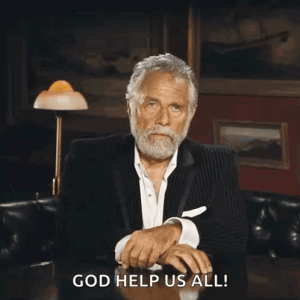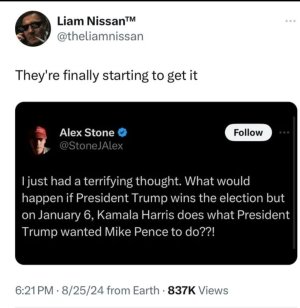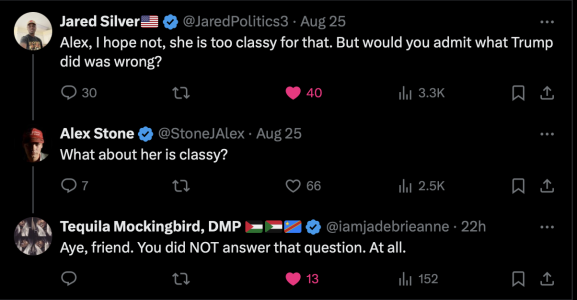You are using an out of date browser. It may not display this or other websites correctly.
You should upgrade or use an alternative browser.
You should upgrade or use an alternative browser.
2024 Presidential Election
- Thread starter PF5
- Start date
The endless race
 | By Adam Nagourney I’ve covered every presidential campaign since 1988. |
Not this year. The late entry of Kamala Harris means her campaign against Donald Trump will last for less than four months, from July 21, when President Biden dropped out of the race, until November 5.
Why, some voters and analysts now wonder, can’t we do it like this every cycle?
In today’s newsletter, let’s consider the benefits of this relatively short contest — and why we might not miss the bloated campaigns of recent decades.
The long campaign
Jimmy Carter, a little-known former governor from Georgia, turned up in Iowa in early 1975 to campaign for the 1976 caucuses. The Democratic National Committee had recently changed the rules after the chaotic 1968 convention, shifting nominating power from party bosses to states like Iowa. Carter’s “presidential aspirations have been considered laughable,” as The Times put it in a story in October 1975. But he won, his first step to capturing the presidency, and created a model for long campaigns that both parties embraced.

|
Jimmy Carter in 1976. Associated Press Photo |
It also offers an inexperienced candidate a chance to learn how to run for national office — how to answer questions, hear voter concerns, master complex issues. A long campaign gives a candidate time to refine positions and overcome beginner mistakes. Candidates grow: They become more confident, more conversant with issues, more comfortable making arguments and parrying challenges. I witnessed that with Bill Clinton, Bob Dole and Hillary Clinton. Obama was often stiff and jargony in the early days of his candidacy; slowly and over many months, he blossomed into the politician we know today.
Harris’s first presidential campaign, in 2020, ended before the first primary, so she never got this sort of boot camp. No wonder some Democrats worried about how nimble she’d be this fall.
The short campaign
Yet long campaigns can sap the public’s interest and energy, a dynamic that had clearly taken hold before Biden dropped out. A year of attacks and squabbling can breed cynicism and sow distrust of the political system in the electorate. And early primaries with more extreme voters “tug candidates to places that can hurt them later in the race,” the political consultant David Axelrod told me.
|
Howard Dean, the former governor of Vermont, in 2004. Ruth Fremson/The New York Times |
Politicians in other advanced democracies don’t spend nearly as much time on campaigns. Mexico, Japan and much of the European Union, for instance, have laws limiting them. French presidential races can’t officially start until two weeks before the first round of voting. The U.K. held a nationwide parliamentary election this summer in about six weeks. In Japan, campaigns last just 12 days. Citing declining public trust, the country’s governing party last week announced that it would lengthen that period for its next leadership election — to 15 days.
Harris is benefiting from the short campaign. She has been able to avoid releasing detailed policy ideas — which Trump could attack — with the plausible argument that she wasn’t even a candidate until last month. She hasn’t been tested in spontaneous settings. “If Biden had withdrawn a year earlier, Harris would have struggled in a marathon race,” Scott Reed, the Republican consultant who managed Bob Dole’s presidential campaign in 1996, told me.
A fixed fate?
The contest between Harris and Trump offers a natural experiment showing what it might be like if, somehow, the parties returned to shorter campaigns. What if, say, primary season began after the school year ended? What if every state voted for nominees at once, or in 10-state blocs over five weeks? What if Americans didn’t have to sit through 15 months of caustic ads?There is a powerful constituency in this country for doing things the way they have always been done. The potential 2028 (or 2032) Democratic presidential candidates were already meeting with donors and jostling to give prime-time speeches at the convention in Chicago last week. And this is big business. The campaign machine supports high-paid consultants, strategists and pollsters; advertisements on local television stations; and hotel, bar and restaurant bills across the country. (About $14.4 billion went into the last presidential contest.) For political aficionados who never want it to end — I count myself in that group — it’s tough to admit that a short campaign might be better for democracy.
But the way this country elects presidents has changed many times since the founding. There’s no reason to think we’re stuck in this slog forever.
PJ-OSU
New member
"Some voters now wonder...", I've always wondered. For one, it seems like a HUGE waste of money that could be used for other things. Also, I don't know anyone that says, "yeah, more political ads for a longer duration is what I want".The endless race
Presidential campaigns are marathons: They start years before Election Day and proceed through door-knocking, living room meetings, candidate debates, newspaper interviews, leafleting, primaries, caucuses and nominating conventions. It’s not unusual, just a few months after a new president is sworn in, to see a contender stake out a state that holds an early primary or caucus.
By Adam Nagourney
I’ve covered every presidential campaign since 1988.
Not this year. The late entry of Kamala Harris means her campaign against Donald Trump will last for less than four months, from July 21, when President Biden dropped out of the race, until November 5.
Why, some voters and analysts now wonder, can’t we do it like this every cycle?
In today’s newsletter, let’s consider the benefits of this relatively short contest — and why we might not miss the bloated campaigns of recent decades.
The long campaign
Jimmy Carter, a little-known former governor from Georgia, turned up in Iowa in early 1975 to campaign for the 1976 caucuses. The Democratic National Committee had recently changed the rules after the chaotic 1968 convention, shifting nominating power from party bosses to states like Iowa. Carter’s “presidential aspirations have been considered laughable,” as The Times put it in a story in October 1975. But he won, his first step to capturing the presidency, and created a model for long campaigns that both parties embraced.
There are good things about a long campaign. It gives voters a chance to see candidates up close instead of only in slick political ads. In 2007, I watched Barack Obama linger in a small hall to answer questions until after the last television crew left.

It also offers an inexperienced candidate a chance to learn how to run for national office — how to answer questions, hear voter concerns, master complex issues. A long campaign gives a candidate time to refine positions and overcome beginner mistakes. Candidates grow: They become more confident, more conversant with issues, more comfortable making arguments and parrying challenges. I witnessed that with Bill Clinton, Bob Dole and Hillary Clinton. Obama was often stiff and jargony in the early days of his candidacy; slowly and over many months, he blossomed into the politician we know today.
Harris’s first presidential campaign, in 2020, ended before the first primary, so she never got this sort of boot camp. No wonder some Democrats worried about how nimble she’d be this fall.
The short campaign
Yet long campaigns can sap the public’s interest and energy, a dynamic that had clearly taken hold before Biden dropped out. A year of attacks and squabbling can breed cynicism and sow distrust of the political system in the electorate. And early primaries with more extreme voters “tug candidates to places that can hurt them later in the race,” the political consultant David Axelrod told me.
Overexposed candidates can also make sloppy mistakes. Meanwhile, political reporters look for ways to spice up a boring campaign and sometimes latch onto ancillary issues. For instance, the scream that Howard Dean, the former governor of Vermont, let out after he lost the 2004 Iowa caucuses shadowed the final days of his campaign.

Politicians in other advanced democracies don’t spend nearly as much time on campaigns. Mexico, Japan and much of the European Union, for instance, have laws limiting them. French presidential races can’t officially start until two weeks before the first round of voting. The U.K. held a nationwide parliamentary election this summer in about six weeks. In Japan, campaigns last just 12 days. Citing declining public trust, the country’s governing party last week announced that it would lengthen that period for its next leadership election — to 15 days.
Harris is benefiting from the short campaign. She has been able to avoid releasing detailed policy ideas — which Trump could attack — with the plausible argument that she wasn’t even a candidate until last month. She hasn’t been tested in spontaneous settings. “If Biden had withdrawn a year earlier, Harris would have struggled in a marathon race,” Scott Reed, the Republican consultant who managed Bob Dole’s presidential campaign in 1996, told me.
A fixed fate?
The contest between Harris and Trump offers a natural experiment showing what it might be like if, somehow, the parties returned to shorter campaigns. What if, say, primary season began after the school year ended? What if every state voted for nominees at once, or in 10-state blocs over five weeks? What if Americans didn’t have to sit through 15 months of caustic ads?
There is a powerful constituency in this country for doing things the way they have always been done. The potential 2028 (or 2032) Democratic presidential candidates were already meeting with donors and jostling to give prime-time speeches at the convention in Chicago last week. And this is big business. The campaign machine supports high-paid consultants, strategists and pollsters; advertisements on local television stations; and hotel, bar and restaurant bills across the country. (About $14.4 billion went into the last presidential contest.) For political aficionados who never want it to end — I count myself in that group — it’s tough to admit that a short campaign might be better for democracy.
But the way this country elects presidents has changed many times since the founding. There’s no reason to think we’re stuck in this slog forever.
mugatu
Sheriff
Also... politicians shouldn't be spending half their time in office focused on reelection. They should be focused on legislating."Some voters now wonder...", I've always wondered. For one, it seems like a HUGE waste of money that could be used for other things. Also, I don't know anyone that says, "yeah, more political ads for a longer duration is what I want".
Last edited:
Campaign season is basically its own mini economy at this point. Good luck putting those cookies back in the jar."Some voters now wonder...", I've always wondered. For one, it seems like a HUGE waste of money that could be used for other things. Also, I don't know anyone that says, "yeah, more political ads for a longer duration is what I want".
They aren't in it to govern they are in it to be re-elected and continue to grift.Also... politicians shouldn't be spending half their time in office focused on reelection. They should be focused on legislating.
mugatu
Sheriff
I know that's the case for the large part and it's such BS.They aren't in it to govern they are in it to be re-elected and continue to grift.
And in some cases stay out of jailThey aren't in it to govern they are in it to be re-elected and continue to grift.
Polds4OSU
Marshall
Texas AG, Ken Paxton raids homes of Latino civil rights group members, setting up a voting rights showdown
The raids have triggered outrage and cries of voter suppression in a state with a long history of discrimination against citizens of Mexican descent, which helped give rise to LULAC.

 www.nbcnews.com
www.nbcnews.com
The raids have triggered outrage and cries of voter suppression in a state with a long history of discrimination against citizens of Mexican descent, which helped give rise to LULAC.

Raids of Latino political, civil rights leaders' homes set up voting rights battle in TX
The raids have triggered outrage and cries of voter suppression in a state with a long history of discrimination against citizens of Mexican descent, which helped give rise to LULAC.
Polds4OSU
Marshall
"Six Republicans who are facing criminal charges after signing a document falsely claiming that Donald Trump won Michigan's electoral votes in 2020 were renominated by their party, over the weekend, to be GOP presidential electors this year..."

 www.detroitnews.com
www.detroitnews.com

Six 2020 false Trump electors nominated to represent Michigan Republicans in 2024 election
Pete Hoekstra, chairman of the Michigan Republican Party, contended the 2020 Trump electors were being \
Polds4OSU
Marshall
BREAKING: The Arizona Police Association, which has endorsed former President Trump, has announced they’re endorsing Democratic Congressman Ruben Gallego for Senate in his election against Kari Lake.

 www.threads.net
www.threads.net

James Crocker (@jamescrockerrr) on Threads
BREAKING: The Arizona Police Association, which has endorsed former President Trump, has announced they’re endorsing Democratic Congressman Ruben Gallego for Senate in his election against Kari Lake.
 www.threads.net
www.threads.net
Polds4OSU
Marshall
"He won it the last time too, by the way" -- Trump claims that John James, who lost his 2020 election in Michigan by over 92,000 votes, had victory stolen from him

 www.threads.net
www.threads.net

Aaron Rupar (@aaron.rupar) on Threads
"He won it the last time too, by the way" -- Trump claims that John James, who lost his 2020 election in Michigan by over 92,000 votes, had victory stolen from him
 www.threads.net
www.threads.net
Polds4OSU
Marshall
AP: “Tennessee’s top Republican leaders threatened to withhold tens of millions in state funding from Memphis should leaders continue with plans to place 3 gun control initiatives on the ballot…”
Again: Non-binding initiatives. Authoritarianism at work.

 apnews.com
apnews.com
Again: Non-binding initiatives. Authoritarianism at work.
Tennessee Republican leaders threaten to withhold funds as Memphis preps to put guns on the ballot
Tennessee’s top Republican leaders have threatened to withhold tens of millions of dollars in state funding from left-leaning Memphis should leaders continue with plans to place three gun control initiatives on the November ballot.
Polds4OSU
Marshall
"At 70 years old, running for President was the desperate move of a man who had presidential ambitions but saw the door rapidly closing on the opportunity for him to hold any political office," said Baldwin.

 www.threads.net
www.threads.net

Newsweek (@newsweek) on Threads
"At 70 years old, running for President was the desperate move of a man who had presidential ambitions but saw the door rapidly closing on the opportunity for him to hold any political office," said Baldwin.
 www.threads.net
www.threads.net
Polds4OSU
Marshall
Floating around social media
I’m tired y’all. As a pastors wife, I’m tired. I’m tired of being told who Jesus was. I’m tired of being told I can’t possibly be a democrat and a christian.
My Jesus flipped tables, my Jesus was a radical, my Jesus had women as some of his closest companions, my Jesus stood up for the lost, the last and the least. My Jesus didn’t follow the laws of the land, if he had he wouldn’t have been crucified. My Jesus loved! My Jesus wouldn’t even recognize his flock today.
I’m tired y’all. As a pastors wife, I’m tired. I’m tired of being told who Jesus was. I’m tired of being told I can’t possibly be a democrat and a christian.
My Jesus flipped tables, my Jesus was a radical, my Jesus had women as some of his closest companions, my Jesus stood up for the lost, the last and the least. My Jesus didn’t follow the laws of the land, if he had he wouldn’t have been crucified. My Jesus loved! My Jesus wouldn’t even recognize his flock today.
mugatu
Sheriff
They should be starting to get it. But, no, the delusion is far too strong.
View attachment 6711

Polds4OSU
Marshall
GOP Rep. Roy endorses Trump’s Project 2025 plan to take total control of government by installing MAGA loyalists: “We need to rip [the government] apart... We need to start from the ground up”

 www.threads.net
www.threads.net

Kamala HQ (@kamalahq) on Threads
GOP Rep. Roy endorses Trump’s Project 2025 plan to take total control of government by installing MAGA loyalists: “We need to rip [the government] apart... We need to start from the ground up”
 www.threads.net
www.threads.net
Polds4OSU
Marshall
Outrageous — Speaker Sexton & @ltgovmcnally are threatening to withhold sales taxes from MEMPHIS if they vote to protect themselves from gun violence.

 www.commercialappeal.com
www.commercialappeal.com
Tennessee GOP leadership threatens Memphis sales tax revenue over gun-reform ballot measures
Tennessee General Assembly leadership on Monday threatened to pass new legislation to withhold millions from Memphis.
Similar threads
- Replies
- 3
- Views
- 337
- Replies
- 4
- Views
- 667
- Replies
- 12
- Views
- 916
- Replies
- 6
- Views
- 273


